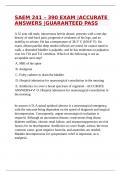SAEM 241 – 390 EXAM |ACCURATE
ANSWERS |GUARANTEED PASS
A 32 year old male, intravenous heroin abuser, presents with a one-day
history of mid-back pain, progressive weakness of his legs, and an
inability to urinate. He has a temperature of 38.3° C (100.8° F). On
exam, absent patellar deep tendon reflexes are noted, he cannot stand or
walk, a distended bladder is palpable, and he has tenderness to palpation
over his T10 and T11 vertebrae. Which of the following is not an
acceptable next step?
A. MRI of the spine
B. Analgesia
C. Foley catheter to drain the bladder
D. Hospital admission for neurosurgical consultation in the morning
E. Antibiotics to cover a broad spectrum of organism - ACCURATE
ANSWERS✔✔ D. Hospital admission for neurosurgical consultation in
the morning
he answer is D. A spinal epidural abscess is a neurosurgical emergency,
with the outcome being dependent on the speed of diagnosis and surgical
decompression. Consequently, urgent neurosurgical evaluation is
required. Although an uncommon disease, intravenous drug abuse,
diabetes mellitus, chronic renal failure, and immunosuppression are risk
factors for its development. Antibiotics to cover Staph. aureus, the most
common cause, gram negative bacteria, and anaerobes are needed.
Bladder decompression for symptomatic relief is important, as is
analgesia
,Which of the following is true about myasthenia gravis?
A. It typically presents as an ascending weakness of the peripheral
nervous system.
B. A myasthenic crisis involves an exacerbation of weakness, especially
of respiratory muscles, often necessitating intubation.
C. Weakness improves as the involved muscles are used repeatedly.
D. The "atropine test" is diagnostic when 0.5 mg of atropine is given
intravenously and the patient's symptoms improve within two minutes.
E. Cooling exacerbates the symptoms, and heat alleviates them. -
ACCURATE ANSWERS✔✔ B. A myasthenic crisis involves an
exacerbation of weakness, especially of respiratory muscles, often
necessitating intubation.
The answer is B. Myasthenia gravis is an autoimmune disease that
results from antibodies directed against the acetylcholine receptor
(AChR) at the neuromuscular junction. Destruction of the AchR leads to
fewer receptors available to bind acetylcholine, with a resulting muscle
weakness. Ocular symptoms are usually the first to occur, with diplopia
and ptosis being common. The disease typically worsens as the day
progresses because of repeated use of the muscles involved. Diagnosis is
made with the tensilon test, where edrophonium is given and the
patient's symptoms are observed to transiently improve. The
administration of atropine is not a diagnostic test. Cooling helps the
symptoms and heat exacerbates them. A myasthenic crisis is a feared
complication. Patients develop respiratory failure requiring intubation,
frequently for prolonged periods.
A 36 year old woman on chronic cyclosporine treatment for bilateral
lung transplantation visits the emergency department complaining of
,extreme headache, nausea and vomiting. Her exam is notable for BP
239/165, normal cardiac exam, bibasilar pulmonary rales, and 1+ lower
extremity edema. EKG showed asymmetric inverted T-waves in I, aVL,
and V4-6. In an effort to acutely control her blood pressure, which of the
following is TRUE?
A. Hydralazine decreases myocardial oxygen demand by decreasing
afterload and would not be useful in this setting
B. Nitroprusside would be contraindicated in this patient due to its
relatively slow onset of action
C. Nitroglycerin decreases BP by decreasing venous return and cardiac
output
D. Prolonged nitroprusside therapy may potentially cause
methemoglobinemia
E. Esmolol works through both alpha-1 and selective beta-2 blockade -
ACCURATE ANSWERS✔✔ C. Nitroglycerin decreases BP by
decreasing venous return and cardiac output
The answer is C. Relative to other anti-hypertensive agents,
nitroprusside has an extremely rapid onset of action. Although rare,
long-term nitroprusside treatment may lead to cyanide toxicity in renal
failure patients secondary to the presence of cyanide as an intermediate
metabolite. A history of long-term cyclosporine treatment suggests this
patient likely has some degree of renal insufficiency.
A 14 year-old child presents to the emergency department. His blood
pressure is 210/140. He complains of a headache, nausea, and recent
blurred vision. Of the following choices, the best goal for lowering his
mean arterial blood pressure is to have it drop by:
, A. Until symptoms resolve
B. 5% in the first 5-6 hours
C. 25% in the first hour
D. 50% in the first hour
E. To normal for his age in the first hour - ACCURATE ANSWERS✔✔
C. 25% in the first hour
The answer is C. A systolic BP of 210 or more, or a diastolic BP of 140
or greater, defines hypertensive urgency. With end-organs symptoms, as
above, the presumptive diagnosis is hypertensive emergency. In
hypertensive emergencies, the goal is to decrease mean arterial blood
pressure by 10-25% within the first hour, thereby alleviating symptoms
while not compromising cerebral perfusion.
A 2 year old male is brought to the ED in status epilepticus. He has not
responded to adequate doses of benzodiazepines. Which of the following
possible causes of a seizure must be evaluated for in the emergency
department?
A. Hypoxia
B. Hypoglycemia
C. Toxic ingestion
D. Head trauma
E. All of the above possible causes must be evaluated for - ACCURATE
ANSWERS✔✔ E. All of the above possible causes must be evaluated
for




